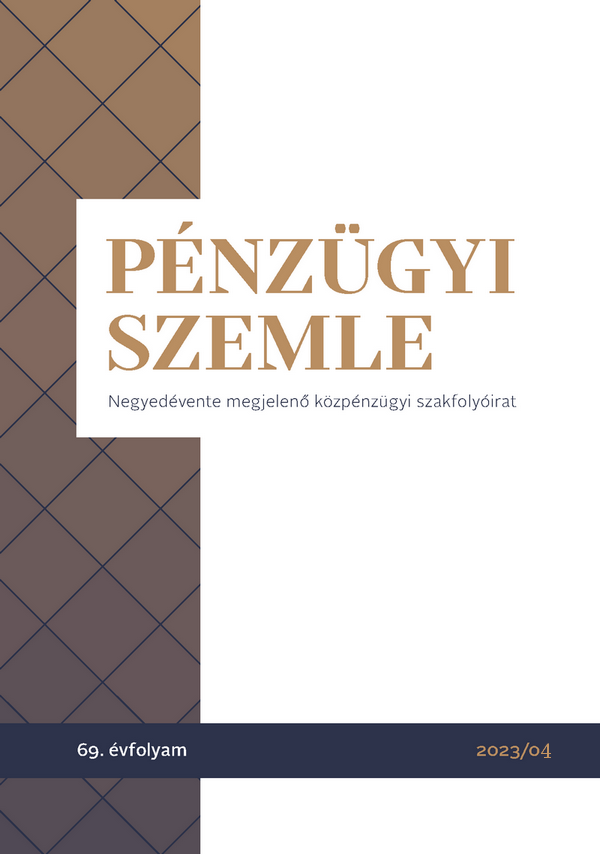The reflexive relationship between financial and social exclusion for the selected Central-Eastern European countries
DOI:
https://doi.org/10.35551/PFQ_2023_4_4Keywords:
Financial exclusion, social exclusion, simultaneous equations model, recursive bivariate probit, Central and Eastern Europe, D14, G21, G41, I32Abstract
This study primarily examines how the risk factors that lead individuals to social exclusion, disadvantage, and deprivation contribute to financial exclusion and vice versa. This causal relationship for financial and social exclusion is formulated using the simultaneous equations model. Along with the causal relationship, this study identifies the leading personal and environmental determinants for both the probabilities of being unbanked and socially excluded. I use demographic, socioeconomic, and geographic information from the Life in Transition Survey III, conducted in 2016. The study found a reflexive causal relationship between financial and social exclusion in the selected Central-Eastern European countries. Namely, people at risk of social exclusion are more likely to be excluded from access to financial services. On the other hand, those at risk of financial exclusion are more likely to be socially excluded.
References
Anderloni, L., Braga, M. D., Carluccio, E. M., & Gloukoviezoff, G. (2007). From Financial Exclusion to Overindebtedness: The Paradox of Difficulties for People on Low Incomes? In New Frontiers in Banking Services (pp. 213–245).
Appleyard, L. (2011). Review Article: Household Finances Under Pressure: What is the Role of Social Policy? Social Policy and Society, 11(1), 131–140. https://doi.org/10.1017/s1474746411000479
Bernad, C., Fuentelsaz, L., & Gómez, J. (2008). Deregulation and its Long-Run Effects on the Availability of Banking Services in Low-Income Communities. Environment and Planning A: Economy and Space, 40(7), 1681–1696. https://doi.org/10.1068/a39222
Bond, P., & Krishnamurthy, A. (2004). Regulating Exclusion from Financial Markets. The Review of Economic Studies, 71(3), 681–707. https://doi.org/10.1111/j.1467-937X.2004.00300.x
Caplan, M. A., Birkenmaier, J., & Bae, J. (2021). Financial exclusion in OECD countries: A scoping review. International Journal of Social Welfare, 30(1), 58–71. https://doi.org/10.1111/ijsw.12430
Carbó, S., Gardener, E. P. M., & Molyneux, P. (2005). Financial Exclusion in Europe. In Financial Exclusion (pp. 98–111). Palgrave Macmillan UK. https://doi.org/10.1057/9780230508743_6
Corrado, G., & Corrado, L. (2015). The geography of financial inclusion across Europe during the global crisis. Journal of Economic Geography, 15(5), 1055–1083. https://doi.org/10.1093/jeg/lbu054
Csorba, L. (2020). The determining factors of financial culture, financial literacy and financial behavior. Public Finance Quarterly, 65(1), 67–83. https://doi.org/10.35551/PFQ_2020_1_6
Demirguc-Kunt, A., & Klapper, L. (2012). Measuring financial inclusion: The Global Findex Database (Policy Research Working Paper Series No. 6025). The World Bank. https://EconPapers.repec.org/RePEc:wbk:wbrwps:6025
Demirgüc-Kunt, A., Klapper, L., Singer, D., Ansar, S., & Hess, J. (2018). The Global Findex Database 2017: Measuring financial inclusion and the fintech revolution. The World Bank. https://globalfindex.worldbank.org/
Dymski, G. A. (2003). Immigration, finance, and urban evolution: An illustrative model, with a Los Angeles case study. The Review of Black Political Economy, 30(4), 27–50. https://doi.org/10.1007/bf02687549
European Commission. (2022). Cohesion in Europe towards 2050. Eighth report on economic, social and territorial cohesion. Publications Office of the European Union Luxembourg.
Fernández-Olit, B., Martín Martín, J. M., & Porras González, E. (2020). Systematized literature review on financial inclusion and exclusion in developed countries. International Journal of Bank Marketing, 38(3), 600–626. https://doi.org/10.1108/IJBM-06-2019-0203
Fernández-Olit, B., Paredes-Gázquez, J. D., & de la Cuesta-González, M. (2016). Are Social and Financial Exclusion Two Sides of the Same Coin? An Analysis of the Financial Integration of Vulnerable People. Social Indicators Research: An International and Interdisciplinary Journal for Quality-of-Life Measurement, 1–24. https://doi.org/10.1007/s11205-016-1479-y
Filippini, M., Greene, W. H., Kumar, N., & Martinez-Cruz, A. L. (2018). A note on the different interpretation of the correlation parameters in the Bivariate Probit and the Recursive Bivariate Probit. Economics Letters, 167, 104–107. https://doi.org/10.1016/j.econlet.2018.03.018
Kearney. (2021). European Retail Banking Radar 2021: Challenges and opportunities in a tumultuous year. https://www.kearney.com/financial-services/european-retail-banking-radar
Koku, P. s. (2015). Financial exclusion of the poor: A literature review. International Journal of Bank Marketing, 33(5), 654–668. https://doi.org/10.1108/IJBM09-2014-0134
Leyshon, A., & Thrift, N. (1995). Geographies of Financial Exclusion: Financial Abandonment in Britain and the United States. Transactions of the Institute of British Geographers, 20(3), 312–341. https://doi.org/10.2307/622654
Myers, J., Cato, M. S., & Jones, P. A. (2012). An ‘alternative mainstream’? The im pact of financial inclusion policy on credit unions in Wales. Public Money & Ma nagement, 32(6), 409–416. https://doi.org/10.1080/09540962.2012.728780
Németh, E., Vargha, B. T., & Domokos, K. (2020). Financial Literacy. Who, whom, and what are they Training for? Comparative Analysis 2016–2020. Public Finance Quarterly, 65(4), 554–583.
Németh, E., Zsótér, B., & Béres, D. (2020). Financial Vulnerability of the Hungarian Population. Public Finance Quarterly, 65(2), 284–311. https://doi.org/10.35551/PFQ_2020_2_8
Pauwels, M.-C. (2011). Ethnicity and Financial Exclusion: How Fringe Banking has taken hold in Ethnic and Immigrant Neighborhoods. Ethnic Studies Review, 34.1, 211–219. https://doi.org/10.1525/esr.2011.34.1.211
Rhine, S. L. w., & Greene, W. H. (2013). Factors That Contribute to Becoming Unbanked. The Journal of Consumer Affairs, 47(1), 27–45. https://doi.org/10.1111/j.1745-6606.2012.01244.x
Rojas, D. S. (2010). Accessing Alternatives: Latino Immigrant Financial Experiences in Virginia. International Journal of Business Anthropology, 1(1), 57–78.
Sprague, A. (2015). Next Generation TANF: Reconceptualizing Public Assistance as a Vehicle for Financial Inclusion. University of the District of Columbia Law Review, 18(1), 144–ii.
Taket, A., Crisp, B. R., Nevill, A., Lamaro, G., Graham, M., & Barter-Godfrey, S. (2009). Theorising Social Exclusion (Vol. 2). Routledge London.
Urquijo, L. G. (2015). Financial Exclusion in the European Union: Addressing Difficulties in Accessing Finance within the Current Integration Framework. Journal of Contemporary European Studies, 23(1), 100–117. https://doi.org/10.10 80/14782804.2014.961059
Wooldridge, J. M. (2015). Introductory econometrics: A modern approach. Cengage learning.
World Bank. (2014). Global Financial Development Report.
Downloads
Published
How to Cite
Issue
Section
License
Authors assign copyright to Pénzügyi Szemle / Public Finance Quarterly. Authors are responsible for permission to reproduce copyright material from other sources.












